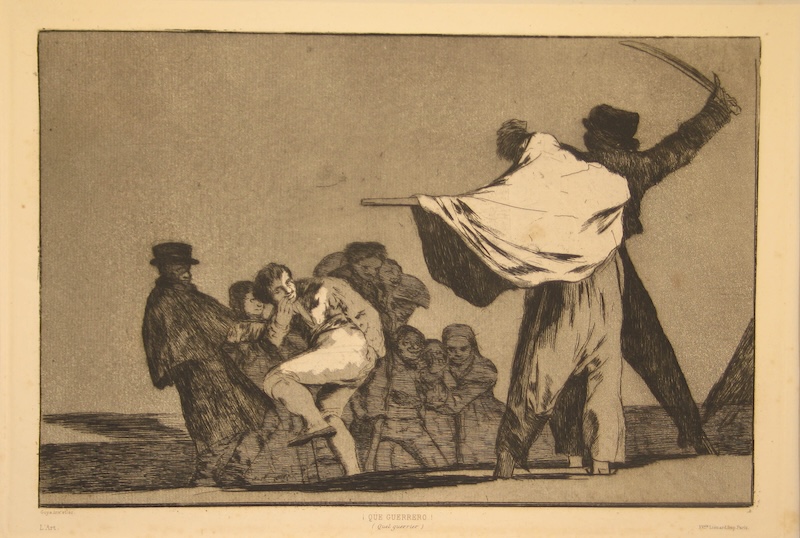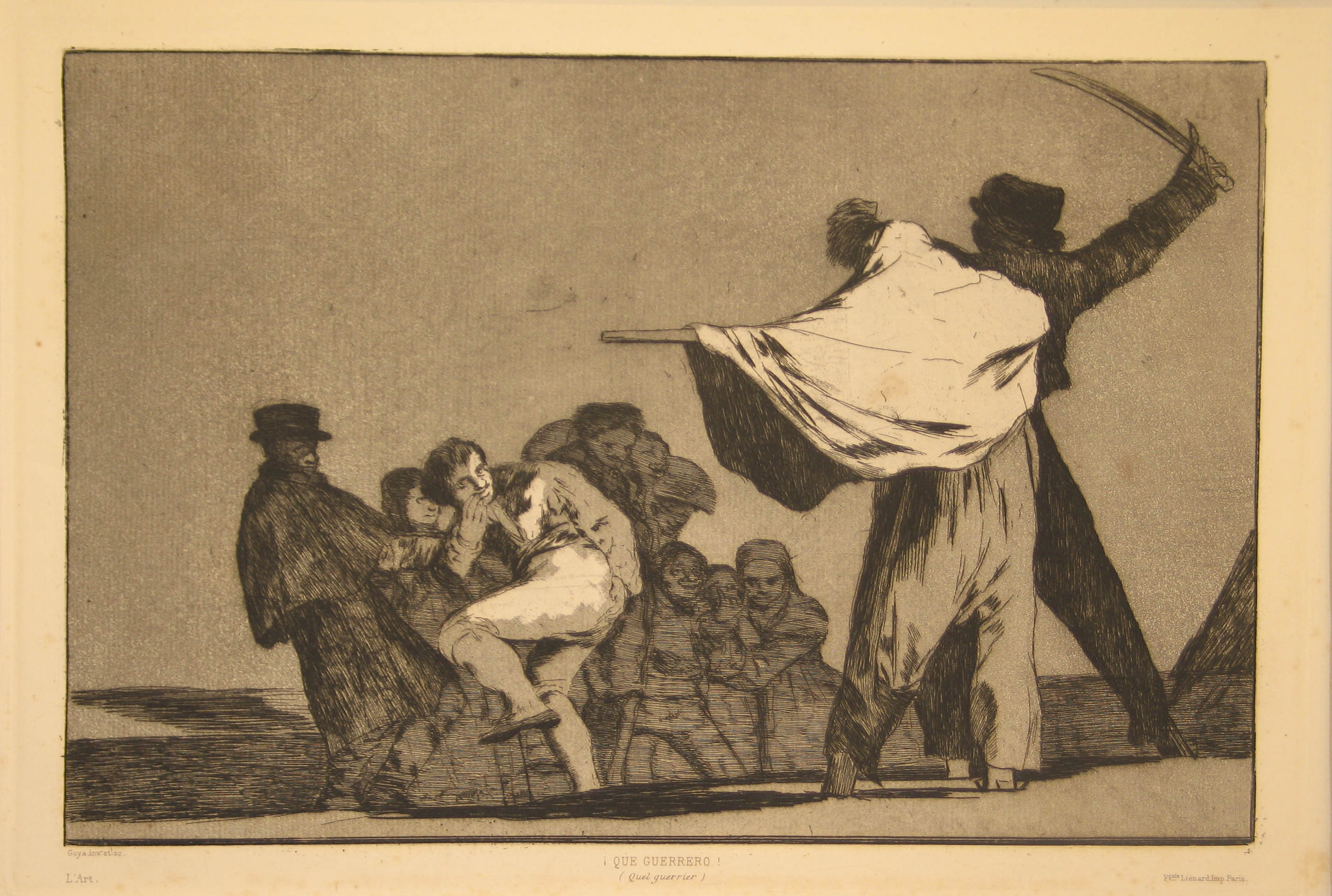Object of the Month: "!Que Guerrero! (What a Warrior!)" by Francisco José de Goya y Lucientes
By Bowdoin College Museum of Art
Francisco José y Lucientes de Goya, !Que Guerrero! (What a Warrior!), 1816-1817, etching and aquatint on cream laid paper. Bowdoin College Museum, Brunswick, Maine. Gift of Charles Pendexter, 2009.16.354
¡Qué guerrero! (What a Warrior!) is an etching by Francisco José de Goya y Lucientes (Spanish, 1746–1828) from his series Los Disparates (The Follies), also known as Proverbios (Proverbs). Goya created these prints between 1815 and 1823, just before relocating to Bordeaux, France. Scholars have struggled to interpret the enigmatic etchings, though most agree they contain symbols satirizing the church, military, and other authoritative institutions of nineteenth-century Spain. Given the provocative nature of the works, which were made in an oppressive sociopolitical landscape during the Spanish Inquisition, the series was never published during Goya’s lifetime. They were first printed in 1864 by the Academia de San Fernando in Madrid with the title Los Proverbios.[i]
I first encountered Goya’s etching during the fall 2022 semester as a student in Professor Mary Hart’s “Printmaking I” class. We visited the Zuckert Seminar Room to examine a selection of exemplary prints from the Museum’s collection meant to inspire our own creative projects. In this setting, I was able to study ¡Qué guerrero! in person and found myself intrigued both by what it could teach me technically about the etching process and by the mystery of its content.
Goya made this print with a combination of etching and aquatint. Etching involves covering a metal plate in an acid-resistant material called ground. The artist scratches their composition into the ground with a stylus known as an etching needle. The plate is then exposed to acid, which bites only into the areas of exposed metal that were carved away, leaving behind the design the artist engraved onto the plate. After the ground is wiped away and the artist inks the plate, the pigment only adheres to the etched lines. The plate is then pressed against paper, transferring the ink to the sheet. Many etchings use cross-hatching or varying densities of line to indicate light, shadow, and shading. However, Goya expertly employs an additional technique called aquatint to introduce a more complex tonal range.[ii] Aquatint involves a material such as powdered resin that is brushed on the metal plate in the places where tone and shading are desired. When the plate is exposed to acid, the parts covered by the resin are protected and remain lighter in color than those parts of the plate that are exposed to the acid. To produce a range of tones, aquatint can be done in different stages so that different parts of the plate are exposed to the acid for varying amounts of time. Close observation of Goya’s masterful etching and aquatint print offered insight into how to use these processes in my own work to convey mood and delineate areas of visual interest. However, despite many hours spent sketching detailed studies to later inform my own printmaking practice, I was left with more questions than answers about what the work may reveal.
The years during which Goya created Disparates were marked by turmoil in Spanish society. After Napeolon had been defeated in Spain, King Ferdinand VII regained power, immediately abolishing the liberal constitution and reestablishing an absolute monarchy. King Ferdinand VII’s rule was turbulent; it was a time of immense repression but also triumph and hope as a military revolt forced Ferdinand VII to reinstate the constitution in 1820. The sarcastic, confusing, and sometimes disturbing scenes depicted in Disparates reflect Goya’s views on the political system of his country at the time.[iii]
In ¡Qué guerrero!, an unlit crowd recoils from two anthropomorphic figures. One is ane dark silhouetted figure raising a sword and other is a lighted silhouette figure concealed by a cape. In the front of the cowering group, a singular man stands illuminated. He is posed with his hand covering his mouth as he faces his backside to the threatening figures. Although at first glance this scene may appear as a moment of terror, a closer look at various minor details demonstrates a satirical tone. First, there are glimpses of what appear to be wood, rather than limbs, peeking out from the bottom of the pants and jutting out of the side of the light silhouette signaling the potential of a falsely created human figure. This detail suggests that the threatening figure desires to be seen as a bigger danger or more powerful figure of authority than he is in reality. Additionally, the illuminated figure in the crowd could be seen as cowering, but the smirk on his face and the position of his body indicate the ridiculing and taunting of the threatening figure. These hints in ¡Qué guerrero! make its satirical nature clear, echoing Goya’s cynical view and personal distaste for Spanish authority of the time.
Pilar Saavedra-Weis ’25Curatorial Assistant


[i] “Title page for "Los Proverbios" (Disparates),” The Metropolitan Museum of Art, accessed Feb. 23, 2025, https://www.metmuseum.org/art/collection/search/384318.
[ii] “Goya’s Technique”, Benton Museum of Art Pomona College, accessed Feb. 23, 2025, https://www.pomona.edu/museum/collections/etchings-francisco-de-goya/technique-goya#:~:text=The%20process%20involves%20covering%20a,transferred%20them%20to%20the%20plates.
[iii] “Disparate conocido / ¡Qué guerrero!”, Colección Banco de España, accessed Feb. 23, 2025, https://coleccion.bde.es/wca/es/secciones/coleccion/obras/disparate-conocido---que-guerrero--g_2357_3.html#.